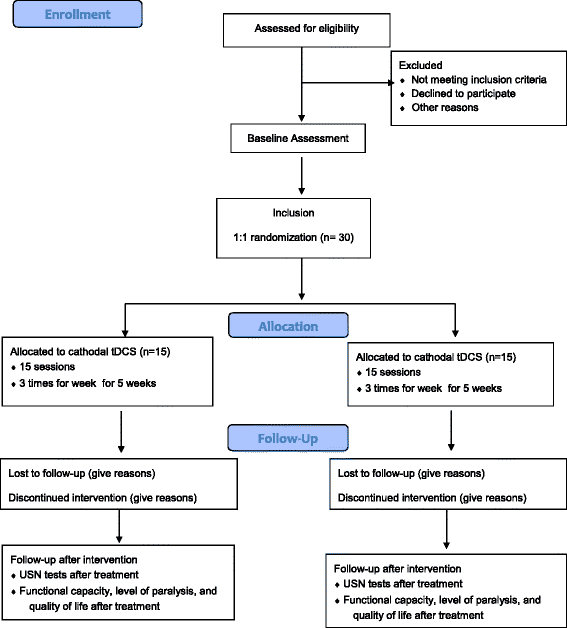Treatment of unilateral spatial neglect after stroke using transcranial direct current stimulation (ELETRON trial): study protocol for a randomized controlled trial
- PMID: 27716442
- PMCID: PMC5048673
- DOI: 10.1186/s13063-016-1598-4
Treatment of unilateral spatial neglect after stroke using transcranial direct current stimulation (ELETRON trial): study protocol for a randomized controlled trial
Abstract
Background: Unilateral spatial neglect (USN) is characterized by the inability to report or respond to people or objects that are presented in the spatial hemisphere that is contralateral to the lesioned hemisphere of the brain. USN has been associated with poor functional outcomes and long stays in hospitals and rehabilitation centers. Noninvasive brain stimulation, such as transcranial direct current stimulation (tDCS), has been used in people who have been affected by USN after stroke. The effects of such treatment could provide new insights for health professionals and policy-makers. The aim of this study will be to evaluate the effectiveness and safety of tDCS for USN after stroke.
Methods: A prospective randomized controlled trial with two parallel groups will be conducted, which will aim to recruit 60 patients with USN after ischemic or hemorrhagic stroke. Participants will be randomly placed into the following four treatment groups: (1) anodal tDCS over the right parietal lobe (n = 15), (2) cathodal tDCS over the left parietal lobe (n = 15), (3) a sham group of anodal tDCS over the right parietal lobe (n = 15), and (4) a sham group of cathodal tDCS over the left parietal lobe (n = 15). Blinded assessors will conduct two baseline assessments and one post-intervention assessment. The primary outcome measure will be the level of USN as assessed by the conventional Behavioral Inattention Tasks and the Catherine Bergego Scale. Secondary measures will include neurological capacity (based on the Scandinavian Stroke Scale), functional capacity (based on the Functional Independence Measure and Modified Rankin Scale), autonomy (based on the Barthel Index), and quality of life (based on the EuroQol-5D). Group allocation will be concealed, and all analyses will be based on an intention-to-treat principle.
Discussion: This study will explore the effects of more than 15 sessions of tDCS on the level of USN, functional capacity, autonomy, and quality of life in patients with USN after stroke. This proposed study has the potential to identify a new, evidence-based intervention that can enhance perception and independent living in patients with USN after stroke.
Trial registration: REBEC - RBR-78jvzx , registered on 13 March 2016.
Keywords: Stroke; Transcranial direct current stimulation; Unilateral spatial neglect.
Figures
References
Publication types
MeSH terms
Associated data
LinkOut - more resources
Full Text Sources
Other Literature Sources
Medical



